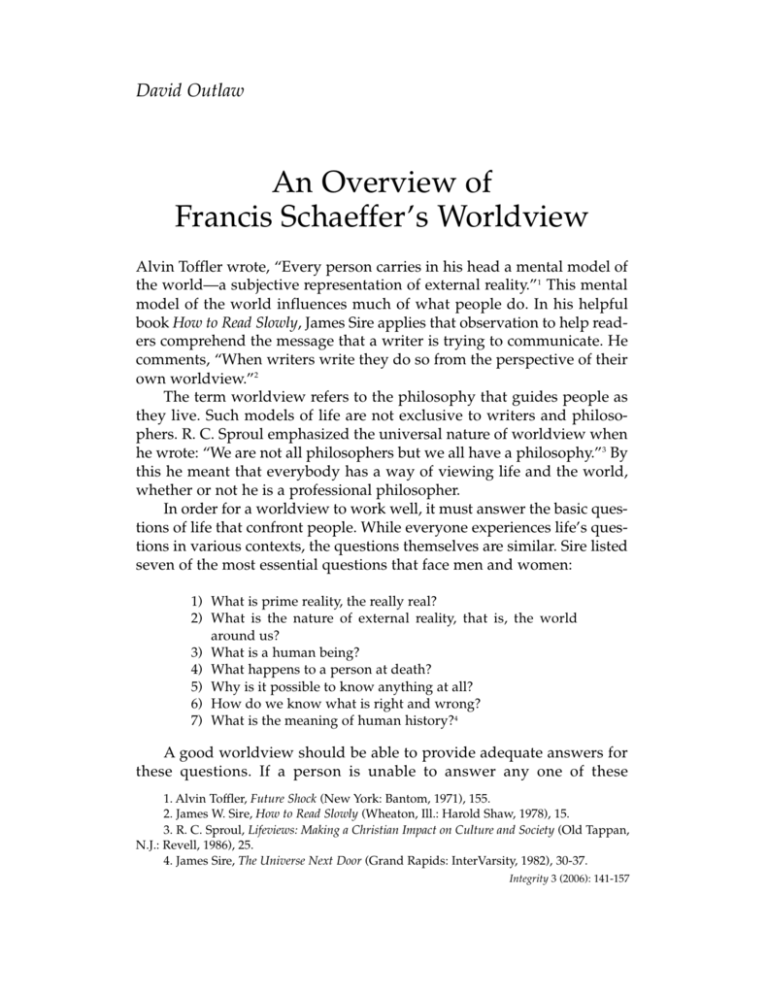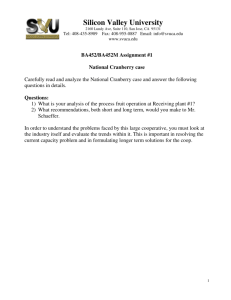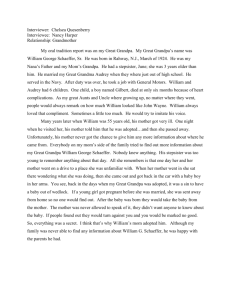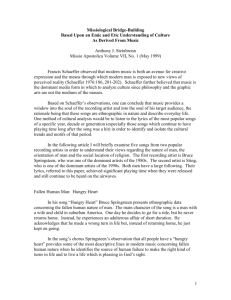An Overview of Francis Schaeffer's Worldview
advertisement

David Outlaw An Overview of Francis Schaeffer’s Worldview Alvin Toffler wrote, “Every person carries in his head a mental model of the world—a subjective representation of external reality.”1 This mental model of the world influences much of what people do. In his helpful book How to Read Slowly, James Sire applies that observation to help readers comprehend the message that a writer is trying to communicate. He comments, “When writers write they do so from the perspective of their own worldview.”2 The term worldview refers to the philosophy that guides people as they live. Such models of life are not exclusive to writers and philosophers. R. C. Sproul emphasized the universal nature of worldview when he wrote: “We are not all philosophers but we all have a philosophy.”3 By this he meant that everybody has a way of viewing life and the world, whether or not he is a professional philosopher. In order for a worldview to work well, it must answer the basic questions of life that confront people. While everyone experiences life’s questions in various contexts, the questions themselves are similar. Sire listed seven of the most essential questions that face men and women: 1) What is prime reality, the really real? 2) What is the nature of external reality, that is, the world around us? 3) What is a human being? 4) What happens to a person at death? 5) Why is it possible to know anything at all? 6) How do we know what is right and wrong? 7) What is the meaning of human history?4 A good worldview should be able to provide adequate answers for these questions. If a person is unable to answer any one of these 1. Alvin Toffler, Future Shock (New York: Bantom, 1971), 155. 2. James W. Sire, How to Read Slowly (Wheaton, Ill.: Harold Shaw, 1978), 15. 3. R. C. Sproul, Lifeviews: Making a Christian Impact on Culture and Society (Old Tappan, N.J.: Revell, 1986), 25. 4. James Sire, The Universe Next Door (Grand Rapids: InterVarsity, 1982), 30-37. Integrity 3 (2006): 141-157 142 INTEGRITY: A JOURNAL OF CHRISTIAN THOUGHT questions, it exposes a weakness in his worldview that may result in confusion and error. There is a plethora of worldviews. As unique as the individual that holds them, so is the worldview. In The Universe Next Door Sire explored several major worldviews: Deism, Naturalism, Nihilism, Existentialism, Eastern pantheistic monism, and the New Age thinking. Each one of these provides different answers and different ways to answer the questions that people face in life. The different worldviews are not equally valid. Some give false answers to major questions, confuse the issues, or give no answers at all. Norman Geisler offered several tests for determining the strength of a worldview. First, a view of life should be consistent. It should not contradict itself. Second, a view of life should be comprehensive. All of reality needs to be included. Third, a view of life must be livable. If it is not, it is useless. Fourth, a view of life must be consistently affirmable. It must not be self-refuting.5 Of twentieth-century evangelical writers who thought in terms of worldview, few compare to Francis Schaeffer in the influence he had among evangelical preachers, thinkers, activists, and writers. Schaeffer was born in 1912 to working-class parents near Philadelphia. After his conversion as a teenager Schaeffer soon exhibited the characteristics of a thinker. He received his education at Vi rginia’s Hampden-Sydney College and furthered his education with seminary studies at Westminster and Faith. Schaeffer served as a pastor and missionary to Europe before starting a study center named L’Abri in the Swiss Alps in the summer of 1965. Through lectures and writing Schaeffer’s thoughtful approach to the Christian faith gained worldwide attention before his death in May of 1984. Schaeffer’s influence is still felt through the ministry of current evangelical thinkers who were influenced by his thinking and writing, including Os Guiness, Chuck Colson, John Whitehead, Tim LaHaye, and Jerry Falwell. This paper will seek to investigate the major categories of Schaeffer’s worldview along with its specific content. THE CONTENT OF SCHAEFFER’S WORLDVIEW God Of primary importance to Schaeffer’s worldview was his understanding of God. As Steve Brown has written: “The answer to the 5. Norman Geisler, Worlds Apart: A Handbook on World Views (Grand Rapids: Zondervan, 1989), 263-68. OUTLAW: AN OVERVIEW OF FRANCIS SCHAEFFER’S WORLDVIEW 143 question of God’s nature will not only determine how I will act, but it will also determine who I am.”6 Three ideas prove to be of monumental importance for anyone interested in understanding Schaeffer’s thought. First, Schaeffer doggedly defended the true existence of God. Theism may seem to be an obvious inference for a Presbyterian preacher, but Schaeffer spoke of it with a deliberateness and fervency reflected in the title of his book The God Who Is There. In that 1972 release he explained, “The greatest antithesis of all is that God exists as opposed to His not existing: He is the God who is there.”7 Later in the same book he emphasized the crucial nature of God’s existence: “Christian faith turns on the reality of God’s existence, His being there.”8 When declaring God’s existence, Schaeffer did not mean merely that the idea of God was helpful or that some type of divine being exists. He clarified: “Let us notice carefully that in saying God is there, we are saying God exists, and not just talking about the word god, or the idea god. We are speaking of the proper relationship to the living God who exists.”9 Although Schaeffer sought to offer a defense for the existence of God, he avoided couching his arguments in Thomistic terminology. R. C. Sproul, John Gerstner, and Arthur Lindsley observed this tendency, noting that, “Instead of strongly stressing theistic proofs these Evangelicals [i.e., presuppositionalists] almost gloss over them in their eagerness to come to biblical data. But theistic proof is there.”10 Sproul accurately stated that theistic proof exists in Schaeffer’s writings. Three such implicit proofs show themselves repeatedly. One is that there is no meaning behind truth without God. Two is that the existence of God is the only solution to the problem of man. Three is the idea that only a personal creator could create humanity with personality. These three, which serve as proofs in Schaeffer’s mind, are introduced in The God Who Is There and form the bedrock for discussions in later books. The second idea is that Schaeffer’s arguments for the existence of God naturally lead into his concern for the personal nature of God. 6. Steve Brown, If God Is in Charge: Thoughts on the Nature of God for Skeptics, Christians, and Skeptical Christians (Grand Rapids: Baker, 1983), 13. 7. Francis Schaeffer, The God Who Is There, in The Complete Works of Francis Schaeffer, 5 vols. (Wheaton, Ill.: Crossway, 1982), 1:47. The Complete Works of Francis Schaeffer is hereafter cited as CWFS. 8. Ibid., 145. 9. Ibid., 146. 10. R. C. Sproul, John Gerstner, and Arthur Lindsley, Classical Apologetics: A Rational Defense of the Christian Faith and a Critique of Presuppositional Apologetics (Grand Rapids: Zondervan, 1984), 128. 144 INTEGRITY: A JOURNAL OF CHRISTIAN THOUGHT Existence and personality tie in at the point of logical necessity. He reasoned that it would be impossible for a personal creature to originate from anything less than a personal creator. His best explanation of this idea came from an illustration: Imagine you are in the Alps, and from a high vantage point you can see three parallel ranges of mountains with two valleys in between. In one valley there is a lake, but the other is dry. Suddenly you begin to witness what sometimes happens in the Alps; a lake forming in the second valley where there was none before. As you see the water rising, you may wonder what its source is. If it stops at the same level as the lake in the neighboring valley, you may, after careful measurements, conclude that there is a possibility that the water has come from the first valley. But if your measurement shows that the level of the second lake is twenty feet higher than the first, then you can no longer consider that its source may be from the neighboring valley and you would have to seek another explanation. Personality is like that; no one has ever thought of a way of deriving personality from nonpersonal sources.11 Personality in man and God thus forms the hinge of Schaeffer’s thought. He reasoned that, if man is personal, then God must be personal as well. It would be difficult to overstate the significance of the idea of personality to Schaeffer’s overall approach. He started with an observable fact, namely, man is a personal being. From that vantage point he reasoned that such personality could not be the product of chance but the creation of a God who exists in reality. Not only must this God exist, but he must also be a personal being in order to create such a being. Finally, he reasoned that it only makes sense that a personal being would communicate to others in order to make himself known. One can safely regard personality as a major element in the thought of Schaeffer concerning God, man, and the relationship that they enjoy. Third, Schaeffer earnestly contended for the idea that the personal God who is really there communicates to his people. The necessity of God’s communication shines in He Is There and He Is Not Silent. Interestingly, God’s communication is dependent on his existence and personal nature. God’s communication to humanity is another step in the logical sequence evident in much of Schaeffer’s thought. Schaeffer is not alone in this emphasis. Gerald Bray utilized a similar approach: 11. Schaeffer, God Who Is There, 94. OUTLAW: AN OVERVIEW OF FRANCIS SCHAEFFER’S WORLDVIEW 145 How is Christian belief different from other kinds of knowledge? We have already said that God makes himself known to us by revelation. This means that unless he tells us about himself, we cannot know him. This may seem unacceptable to those who think that God should be available for investigation in the same way as the roundness of the earth is, but if we think about it a little more we shall see that we are talking about two different kinds of knowledge. If God is a personal being, it is not surprising that we can know him only by revelation, since the same is true of every person. Other people know us only to the extent that we reveal ourselves to them.12 The point is obvious: if a personal being desires to be known, he must reveal something about himself to someone else. Schaeffer’s emphasis upon God as a personal being who exists and reveals something about himself to his creatures is key to watching his worldview unfold. These three theological ideas form the foundation from which the rest of Schaeffer’s worldview grows. Man Man’s relationship to God was a primary concern to Schaeffer who described himself more frequently as an evangelist than an apologist or theologian. His understanding of the nature of man is an essential part of his worldview. His thoughts about humanity may be categorized under two headings. First, he wrote of man as a being created in the image of God. Second, he presented man as a being who has fallen into sin. Lest there be any confusion, Schaeffer stated bluntly: “In historic Christianity a personal God creates man in His own image.”13 This is not a fact without consequence. Louis Parkhurst remarked on the consequence: “We are finite, personal miniatures of the God who created all that is. If we say we are only animals or machines or nothing, and if we try to live on that basis, we cannot do so consistently in the world God has made for us to live in.”14 This uniqueness from the rest of creation is most evident in human personality. It would be frustrating to live without recognizing such uniqueness. Previously, we observed that personality was a key factor in Schaeffer’s understanding of man. He coined the phrase “manishness of 12. Gerald Bray, The Doctrine of God, Contours of Christian Theology Series, ed. Gerald Bray (Downers Grove, Ill.: InterVarsity, 1993), 15. 13. Schaeffer, God Who Is There, 99. 14. Louis Gofford Parkhurst, Francis Schaeffer: The Man and Message (Wheaton, Ill.: Tyndale House, 1985), 159-60. 146 INTEGRITY: A JOURNAL OF CHRISTIAN THOUGHT man” to refer to “those aspects of man, such as significance, love, rationality and the fear of nonbeing, which mark him off from animals and machines and give evidence of his being created in the image of God.”15 The fact that people are created in the image of God means that they are personal beings, they possess significance, and one should communicate to them as such. Personality is the factor that separates people from the rest of God’s creation. At the point of God’s infinite attributes a gap stands between God and all of creation. At the point of personality, however, “the break comes between man and the rest of creation.”16 Personality is also key to redemption in Schaeffer’s thinking. Because man is a personal being, “the incarnation and the death of the Son of God for the sake of man’s salvation are sensible.”17 Only in bearing God’s image did man stand eligible for salvation. There could have been no incarnation through an animal without rational or moral capacity. Schaeffer challenged Christians to realize that the world is searching for “the reality of personality.” Their problem is that their view of an impersonal or chance universe cannot support the idea of personality. On the other hand, Christianity holds the answer they need because it shows that personality is “rooted in the personal God who has always been.”18 Personality affords man a unique place in relation to God; man “was made to have a personal relationship with Him. Man’s relationship is upward and not merely downward.”19 Consequence number two arising from the image of God in man is that man is endowed with special significance. Schaeffer responded to the Marquis de Sade, Francis Crick, Sigmund Freud, and B. F. Skinner, who saw man as the result of chemical, psychological, and sociological factors. Schaeffer countered by stressing that God made a universe outside himself and that man is “a significant man in a significant history, who can choose to obey the commandment of God and love Him, or revolt against Him.”20 Significance flows from the fact that man as a personal being has a personal relationship with his creator whether that relationship be one of obedience or rebellion. Schaeffer wrote concerning the command to love God, “Surely it is the first commandment because it is the one that 15. Schaeffer, God Who Is There, 201. 16. Ibid., 102. 17. Ibid., 103. 18. Ibid., 169. 19. Francis Schaeffer, Escape from Reason, in CWFS, 1:222. 20. Schaeffer, God Who Is There, 113. OUTLAW: AN OVERVIEW OF FRANCIS SCHAEFFER’S WORLDVIEW 147 expresses the purpose of man and individually, my purpose.” In his excitement he not only derives from this command that God exists, is personal, and reveals something about himself to man, but also that “it tells me something very fundamental and exciting about myself.”21 Man’s significance has a meaning that Schaeffer intended to use as an evangelistic tool. When working outside the Christian framework, man has difficulty seeing purpose or meaning. Schaeffer observed that, “Man made in the image of God cannot live as though he is nothing; so he places in the upper story all sorts of desperate things.”22 Here his thought touches the area of epistemology, but the connection illustrates a valuable point. Man, being designed for a personal relationship with God, finds it nearly impossible to live without recognition of that relationship. Millard Erickson also expressed the importance of the image of God in man: Every human being is God’s creature made in God’s own image. God endowed each of us with the powers of personality that make possible worship and service of our Creator. When we are using those powers to those ends, we are most fully what God intended us to be. It is then that we are most completely human.23 People may try to place something else in that relationship, but, in general, the relationship must exist because that is where man finds his significance. A third consequence of the image of God in man is that this image should be recognized when communicating to people. One sees this thought clearly when Schaeffer declared that “we cannot apply mechanical rules”24 when speaking to people. Certain principles generally apply to every person, but “if we are truly personal, as created by God, then each individual will differ from everyone else.”25 Mindful of the value of God’s image-bearing people, Schaeffer encouraged Christians: “We must remember that the person to whom we are talking, however far from the Christian faith he may be, is an imagebearer of God. He has great value, and our communication to him must be in genuine love.”26 This communication of love also demands that we 21. Ibid., 159. 22. Schaeffer, Escape from Reason, 242. 23. Millard Erickson, Christian Theology (Grand Rapids: Baker, 1983), 517. 24. Schaeffer, God Who Is There, 130. 25. Ibid. 26. Ibid., 130-31. 148 INTEGRITY: A JOURNAL OF CHRISTIAN THOUGHT speak to the man as a unit. Anything less would be irresponsible in light of what Christians know about the nature of man. Schaeffer later explained that redemption is for the whole man and “there is the real Lordship of Christ over the whole man.”27 Ministry and evangelism must consider this wholeness. The second heading in Schaeffer’s view of man concerns man as a fallen creature. One can only see the true significance of this idea against the backdrop of the first heading. Sin is a problem for people precisely because it damages the image of God in them. Sin is a menace to God’s image-bearing creatures because man, though possessing God’s image, is a flawed creature. The problem is what Schaeffer called the dilemma of man. John E. Voss attempted to clarify Schaeffer’s usage of the term: There is a certain amount of ambiguity in Schaeffer’s use of the term “dilemma of man,” but it is essentially this: man has moral motions, yet he consistently fails to meet the expectations of his own standards. The short-fall between man’s “nobility,” or morality, and his “cruelty,” or immorality, is man’s dilemma.28 It is a dilemma because the image of God is what makes man both the most significant of God’s creatures as well as the most troubled. Schaeffer also observed, “Man is able both to rise to great heights and to sink to great depths of cruelty and tragedy.”29 Ironically, this sin is most tragic in man because of the presence of God’s image. Anthony Hoekema chastised: “What makes sin so heinous is that man is prostituting such splendid gifts. Corruptio optimi pessima: the corruption of the best is the worst.”30 Richard Winter revealed something of Schaeffer’s stress on the fall when he wrote, “I had heard the fall mentioned vaguely before, but not until my time at L’Abri did I understand its full and momentous significance.”31 Schaeffer further commented on the nature of the problem in man when he wrote: 27. Schaeffer, Escape from Reason, 224. 28. John E. Voss, “The Apologetics of Francis A. Schaeffer” (Ph.D. dissertation, Dallas Theological Seminary, 1984), 75. 29. Schaeffer, God Who Is There, 109. 30. Anthony Hoekema, Created in God’s Image (Grand Rapids: Eerdmans, 1986), 85. 31. Richard Winter, “The Glory and Ruin of Man,” in Francis A. Schaeffer: Portraits of the Man and His Work, ed. Lane T. Dennis (Westchester, Ill.: Crossway, 1986), 90. OUTLAW: AN OVERVIEW OF FRANCIS SCHAEFFER’S WORLDVIEW 149 Christianity says man is now abnormal, he is separated from his Creator, who is his only sufficient reference point, not by a metaphysical limitation, but by true moral guilt. As a result he is now also separated from himself. Therefore, when he is involved in cruelty, he is not being true to what he was initially created to be. Cruelty is a symptom of abnormality and a result of a moral, historic, space-time Fall.32 Two concepts in this statement deliver a subtle hope to the fallen race. First is the fact that man in his sinful state is seen as abnormal. Second is that sin imposes true guilt. One may look at these two concepts and wonder how they could hold any hope for man. Hope springs from the fact that, if guilt is real and sin causes man to be abnormal, then a real solution may be possible. The solution, however, must help man become what he was designed to be. Although full deliverance from the human dilemma is not expected in this life, a partial but real step toward it can be experienced. Winter explained: In the area of healing, Dr. Schaeffer often spoke of “substantial, but not complete healing this side of glory.” He was deeply aware of the struggle and battle against sin and of how much we groan with the whole creation, waiting for the completion of our redemption. And, in psychiatry, I am forced to come to terms with the pain and suffering of a fallen world as I see a few people recover quickly, but many who are caught in desperate vicious circles of their own and other’s sin, who need many hours of help.33 The hours of help are required as a result of man’s fallen condition. As broken or abnormal as sin causes people to be, however, Schaeffer saw hope for real but partial healing now and complete healing later. Metaphysics Schaeffer’s discussions in the area of metaphysics run along lines parallel to his understanding of God and man. The reason for this is quite simple. Metaphysics is concerned with the problem of ultimate existence. God and man are key players in existence. Therefore, many ideas and problems discussed in the sections on God and man are also of major concern in the consideration of existence. 32. Schaeffer, God Who Is There, 114. 33. Winter, 92. 150 INTEGRITY: A JOURNAL OF CHRISTIAN THOUGHT Although this question is often relegated to the dusty shelves of philosophy departments, the basic consideration is almost inevitable for anyone who thinks about the basic questions of life. Schaeffer summarized the problem: “We must realize that the existence of man is no greater problem as such than is the fact that anything exists at all.”34 Solutions to this “problem” of existence can be divided into two classes. Some surrender the chase and declare that there is no rational answer. Schaeffer responded that, though some hold to the idea that everything is meaningless, they cannot hold this position with rigid consistency. Irrational answers will be dealt with below under the heading of Knowledge. According to Schaeffer, those who consider that a rational answer to the problems of existence is attainable face three general possibilities. The first option offers that the universe and all that exists came from absolutely nothing. This did not seem to be a defensible position to Schaeffer, so he dismissed it as absurd. Another option holds that the universe and what exists had an impersonal beginning. Personality and what Schaeffer called the “manishness of man” seem to be inexplicable under this scenario. The third option says that the universe experienced a personal beginning. Within the implications of this option Schaeffer set up camp for his exploration of metaphysical problems. A personal beginning is a necessity in Schaeffer’s mind because anything less is incapable of accounting for the complexity of personality that people witness in the world. Cornelius Van Til’s influence on Schaeffer is very evident in this reasoning. One senses the strength of personalism in Van Til’s statement, “In the Trinity there is completely personal relationship without residue.”35 He further asserted that “covenant theology furnishes the only completely personalistic interpretation of reality.”36 One Van Tillian reviewer noted: Van Til finds a close relationship between divine sovereignty and the divine personality. This relationship is very illuminating. It is edifying to observe that only a personal God can be sovereign and only a sovereign God can be an absolute person. That is to say, only a personal being can make choices and carry 34. Francis Schaeffer, He Is There and He Is Not Silent, in CWFS, 1:277. 35. Quoted by John M. Frame, Cornelius Van Til: An Analysis of His Thought (Phillipsburg, N.J.: Presbyterian & Reformed, 1995), 59. 36. Cornelius Van Til, Defense of the Faith, 2d ed. (Phillipsburg, N.J.: Presbyterian & Reformed, 1963), 98. OUTLAW: AN OVERVIEW OF FRANCIS SCHAEFFER’S WORLDVIEW 151 them out, and only a sovereign God can avoid being subject, ultimately, to impersonal principles.37 For Van Til, personalism was an important motif that was transferred to many who sat in his classes and read his books. Although Schaeffer does not give direct credit to Van Til’s influence, the connection is readily apparent. Although inextricably intertwined with the doctrine of God and man, the idea of personalism is the backbone of Schaeffer’s metaphysics. One sees the essence of his metaphysical use of personality when reading: The biblical Christian answer takes us back first to the very beginning of everything and states that personality is intrinsic in what is; not in the pantheistic sense of the universe being the extension of the essence of God, but that a God who is personal on the high order of Trinity created all else.38 Several key facts emerge from this statement. First, Schaeffer believed that Scripture connects personality to the metaphysical problem. Second, he used the idea of personality as a distinguishing mark between Christianity and a pantheistic worldview. Third, he identified God as the personal source of a universe which demonstrates personal characteristics. Schaeffer felt that personalism not only accounted for personhood but also gave an answer to another problem. In explicating the values of personalism Schaeffer introduced the need for both unity and diversity. Unity gives a sense of ultimate truth and meaning to the universe, while diversity is needed to assure that the particulars have meaning as well. Once again the face of Cornelius Van Til emerges in Schaeffer’s thought. In Defense of the Faith Van Til wrote: The many must be brought into contact with one another. But how do we know that they can be brought into contact with one another? How do we know that the many do not simply exist as unrelated particulars? The answer given is that in such a case we should know nothing of them; they would be abstracted particulars. On the other hand, how is it possible that we should obtain a unity that does not destroy the particulars? We seem to get our unity by generalizing, by abstracting from the 37. Frame, 60. 38. Schaeffer, God Who Is There, 93. 152 INTEGRITY: A JOURNAL OF CHRISTIAN THOUGHT particulars in order to include them into larger unities. If we keep up this process of generalization till we exclude all particulars, granted they can all be excluded, have we not stripped these particulars of their particularity? Have we then obtained anything but an abstract universal?39 For Van Til, and later for Schaeffer, it was not enough simply to assert that the universe had a personal source. For such a source, some might suggest gods or forces other than the Triune God of Christianity. When adding the problem of unity and diversity to the equation, however, the Trinity is seen not only as reasonable but as an idea that fits a hole in the puzzle of the universe. When analyzing Van Til’s use of the concept, John Frame explained: God’s plan is a personal one and many, because his nature is one and many. The “manifoldness” of God is seen in the diversity of his attributes, his thoughts, and his plans. But it is seen preeminently in the three persons of the Trinity. There is nothing in the persons that is not in the divine unity, and there is nothing in the divine unity that is not fully expressed in the persons. In God, all particularities are fully united, and all unity is fully expressed in detail. Indeed, God’s oneness is a unity of the richness of his nature, and God’s richness is his “self-contained fullness,” the richness of his uniform character.40 Far from being an idea without foundation, this concept gives ultimate meaning and individual significance. Frame made clear that it is rooted in the Person of God. Schaeffer, though far from Van Til’s depth, employed the same idea in his plea for the metaphysical necessity. He argued: “We need a personal unity and diversity. Without this we have no answer. Christianity has this in the Trinity.”41 He added, “It is not that this is the best answer to existence; it is that it is the only answer.”42 He explained that the only reason we have this answer to the complex problems of human existence is because the God who is there is not silent. Instead, he has spoken to us in terms that we can understand and provided answers to the problems that weigh upon the human soul. These answers are not simply good philosophy; they are the right 39. Van Til, 25. 40. Frame, 75. 41. Schaeffer, He Is There, 287. 42. Ibid., 288. OUTLAW: AN OVERVIEW OF FRANCIS SCHAEFFER’S WORLDVIEW 153 answers to the real problems of life. Schaeffer was not interested in mere philosophical speculation. He explained, “The truth of Christianity is that it is true to what is there.”43 Anything less in his mind would be meaningless, arrogant, and cruel. Christianity answers the real questions that people ask of life. SCHAEFFER’S APPROACH TO KNOWLEDGE Schaeffer understood the critical problem of this generation to be an issue of knowledge. He wrote: “Epistemology is the central problem of our generation; indeed, the so-called ‘generation gap’ is really an epistemological gap, simply because the modern generation looks at knowledge in a way radically different from previous ones.”44 External signs of this gap such as fashion and music are only the edge of a wide chasm that separates two different thought patterns. Schaeffer’s penetrating insights on this point could not have been fully appreciated until the explosion of studies concerning postmodernism. Postmodernism is “the movement in late twentieth-century thought that rejects enlightenment rationalism, individualism, and optimism.”45 As an end result there is a depreciation of absolute truth which spreads into a failure to establish meaningful moral categories. This causes many to scramble in an effort to communicate ultimate values and meaning to a generation that does not seem to speak the language. Schaeffer attempted to trace the shift in values and thought from Kant and Hegel, to the religious existentialism of Kierkegaard, into the secular existentialism of Sartre, Camus, Heidegger, and Jaspers. He coined the phrase “line of despair” to mark an imaginary boundary between the time when thinkers pursued knowledge with the notion that there are absolute truths and the time when the pursuit of knowledge is governed solely by relativism. He summed up the results of his tracing with this observation: Before [the shift in thought] man had a romantic hope that on the basis of rationalism he was going to be able to find a meaning to life, and put universals over the particulars. But on this side of Rousseau, Kant, Hegel, and Kierkegaard, this hope no longer exists; the hope is given up. People today live in a generation that no longer believes in the hope of truth as truth.46 43. Ibid., 290. 44. Ibid., 305. 45. Dennis McCullum, The Death of Truth (Minneapolis: Bethany House, 1996), 283. 46. Schaeffer, He Is There, 312. 154 INTEGRITY: A JOURNAL OF CHRISTIAN THOUGHT This analysis appears to be a critique of postmodern thought before such evaluations were thought to be needed. He attempted to gro u n d Christians in an understanding of knowledge and the nature of truth that would effectively counter the hopelessness experienced by those following a wayward epistemological path. Schaeffer’s epistemology rests upon three pillars which he attempted to establish early in his writing. First, he sees all truth in unity. In contrast to the mind that sees scientific truth with one eye and religious truth with a different one, Schaeffer contended: “Historic Christianity has never separated itself from knowledge. It insists that all truth is one, and we must live and teach this even if twentieth-century thought and theology deny it.”47 No difference can be made between truth in the so-called “real” world and truth in the “religious” world. In Escape from Reason he used an image of a two-story building to illustrate the division often made. Knowledge in the lower story was based on sensory data. It was scientific. Upper story knowledge consisted of religious truths supposedly based on faith rather than fact. Schaeffer maintained that such a line of demarcation jeopardizes epistemology and morality alike. For this reason Schaeffer spoke of “true truth” to signal the presence of truth backed by epistemological and moral certainty. Such certainty demonstrates a unifying link between moral ideology and real world scenarios. This perception of unity stands in stark contrast to the approach of postmodernism. Josh McDowell’s observations support Schaeffer’s diagnosis of the epistemological crisis: “Postmodernism rejects the idea that there exists any ‘grand story’ that explains an individual, local story or any universal Truth by which to judge any single ‘truth’.”48 If religious truth were not just as real as scientific investigation, then Schaeffer saw it as unnecessary. Instead Christians must speak of “true truth” and then “exhibit that it is not just a theory.”49 The second pillar on which Schaeffer’s epistemology rests is that people naturally think in terms of antithesis. He attributed this characteristic to divine design when he wrote, “Our minds are so created by God that we think in antithesis.”50 J. I. Packer observed: 47. Schaeffer, God Who Is There, 153. 48. Josh McDowell and Bob Hostetler, The New Tolerance: How a Cultural Movement Threatens to Destroy You, Your Faith, and Your Children (Wheaton, Ill: Tyndale House, 1998), 37. 49. Schaeffer, God Who Is There, 163-64. 50. Ibid., 184. OUTLAW: AN OVERVIEW OF FRANCIS SCHAEFFER’S WORLDVIEW 155 Schaeffer’s fiercest polemics were accordingly launched against professed Christians who seemed to him to have lost sight of the true antithesis between what God tells us in the Bible and the false alternatives developed by fanciedly autonomous man in the folly of his fallenness.51 Schaeffer believed that antithesis was fundamental to the pursuit of knowledge. One must start with the ability to say that “a” is not “non-a.” He saw this as a line in the sand which could not be surrendered without suffering major defeat. Others observed this feature as well. David Wells saw it when he wrote concerning biblical writers and their prophetic utterances: They had a certainty about the existence, character, and purposes of God, a certainty about his truth, that seems to have faded in the bright light of the modern world. They were convinced that God’s revelation, of which they were the vehicles and custodians, was true. True in an absolute sense. It was not merely true to them; it was not merely true in their time; it was not true approximately. What God had given was true universally, absolutely, and enduringly.52 Absolutes offended many of Schaeffer’s contemporaries in much the same way that they offend the present postmodern thought structure. McDowell explained that in postmodernism, “Truth, whether in science, education, or religion, is created by a specific culture or community and is ‘true’ only in and for that culture.”53 Such a view virtually inoculates one against the gospel in the world. Throughout his ministry, despite difficulty and criticism, Schaeffer steadily maintained that antithesis must be a fundamental feature of the Christian approach to knowledge. The Christian biblical view of reality is either true or false, and if it is true, other views are false. There are, however, certain dangers lurking in the black and white waters of antithesis. James B. Hurley remarked that this approach seemed to lead Schaeffer “to select extreme examples and pose them as polar opposites of the positions that he favored.”54 Guilt on this and 51. J. I. Packer, “No Little Person,” in Reflections on Francis Schaeffer, ed. Ronald Ruegsegger (Grand Rapids: Zondervan, 1981), 11. 52. David F. Wells, No Place for Truth (Grand Rapids: Eerdmans, 1993), 259-60. 53. McDowell and Hostetler, 37. 54. James B. Hurley, “Schaeffer on Evangelicalism,” in Reflections on Francis Schaeffer, 298. 156 INTEGRITY: A JOURNAL OF CHRISTIAN THOUGHT similar charges may be correctly assessed to Schaeffer, but that problem merely demonstrates a danger in excess. Potential excess from a person’s examples does not destroy the validity of the principle itself. The same may be said about Schaeffer’s position concerning antithesis. There may be critiques that do not call for an absolute verdict, but if true antithesis is not maintained, no one can be right. The third pillar of knowledge for Schaeffer is that all people think from established presuppositions. Everyone has presuppositions even if they are not consciously acknowledged. One sees the importance Schaeffer placed on this when he wrote: “The flood-waters of secular thought and liberal theology overwhelmed the Church because the leaders did not understand the importance of combating a false set of presuppositions.”55 These presuppositions are the foundation upon which the epistemological superstructure is to be constructed. In his survey of Schaeffer’s works Ronald Ruegsegger identified the following presuppositions that seem basic in Schaeffer’s construct: there is an infinite, personal God; the universe has a personal beginning; and nature is an open causal system. Of these the first is primary and the others are corollaries. On the other side the non-Christian in Schaeffer’s scheme holds the following: there is no infinite, personal God; the universe has an impersonal beginning; and nature is a closed causal system.56 In addition to the three main pillars of knowledge that Schaeffer stressed, he also used several helpful illustrations to assist in the communication of his analysis in the areas of truth and knowledge. Two are foundational to his writing. In The God Who Is There Schaeffer introduced “the line of despair,” mentioned above.57 Schaeffer explained, “Above this line we find men living with their romantic notions of absolutes, though with no sufficient logical basis.”58 The line of despair is the point when this approach to truth changed. In Schaeffer’s scheme this change occurred in Europe around 1890 and in the United States around 1935. He traced the general movement of the change through geography, society, and finally through disciplines in the order of philosophy, art, music, general culture, and theology. Escape from Reason introduced the idea of upper and lower story knowledge, the second of his two fundamental epistemological 55. Schaeffer, God Who Is There, 7. 56. Ronald Ruegsegger, “Schaeffer’s System of Thought,” in Reflections on Francis Schaeffer, 33. 57. Schaeffer, God Who Is There, 8. 58. Ibid., 8 OUTLAW: AN OVERVIEW OF FRANCIS SCHAEFFER’S WORLDVIEW 157 illustrations. Emerging from the “line of despair” concept, this illustration refers to the absolute dichotomy some established between knowledge reached exclusively by sense data (lower story) and knowledge that is beyond the capacity of the senses (upper story). CONCLUSION S c h a e ff e r’s thought was intentionally broad. Other thinkers plumbed the depths of theological issues in a far greater way than he did. His goal, however, was to understand and then explain how all the issues of life are related. Having discovered the commonality between key issues, the Christian can then see how all of life is subdued under the Lordship of Christ. An understanding of Schaeffer’s worldview thinking provides three challenges for Christian thinkers. First, Christians need to see the value of thinking in the broad categories that Schaeffer utilized. In order for such breadth of thought to be beneficial, it must be well organized; otherwise, it is simply a mass of unrelated knowledge. Broad thinking is only beneficial when developed in the framework of a Christian worldview. Second, God’s people should be willing to think deeply about matters of life, politics, education, and faith. Christian minds should be well exercised in developing all sides of an issue. Inevitably, the Christian mind will be guided by its major, nonnegotiable principles. These first principles, however, should encourage and enable deep thought, not prevent it. Finally, God’s people should never apologize that Christ is at the center of their thought. If one follows a map to a particular location, choices are thereby restricted, but efficiency is enhanced. The glory of God in Christ is the ever present center of the Christian’s thought on any issue. While secular philosophers see religious principles as dead weight that inhibits deep thinking, the Christian realizes that these principles, rather than restricting choices, direct one to the desired destination of thought.






